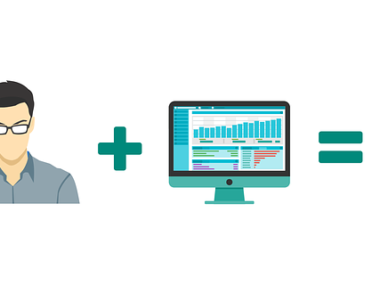welcome to mitrobe network, today, I will be reviewing Dabank Economy in detail, the three components of DaBank Economy; DaBank Economy itself, Syscom and EonNet as well as show how and why Dabank economy is a Syscom sub pyramid scheme.
What is Dabank?
DaBank is a rising conglomerate in the sector of data collection for Market Research, Product Promotion and Advertisement activities. A platform with various Information Technology provisions in the form of business activities, has been designed to share knowledge and express views through social communication, for business purposes.
DaBank facilitates the Netizens to get integrated with the international business community and enjoy a profit share of the huge ongoing turnovers all around. It’s an opportunity to participate in marketing research, advertisement and promotional activities through simple social networking and communication approach.
DaBank Economy is the MLM opportunity.
Syscom is a communication app (calls, chat, file sharing, blogs), with cloud storage. I believe this integrates into EonNet as a purchasable service.
Eonet is a social network of some sort. It doesn’t appear to exist as a standalone service.
Syscom has a website but again fails to disclose any company ownership or management details.
Traffic to both DaBank Economy and Syscom’s website is too low to be ranked by Alexa.
Practically all the marketing I found for DaBank Economy, Syscom and EonNet is targeted at Indians (based on language).
This combined with DaBank Economy and Syscom having UK domains, suggests whoever is running the companies is either in India, or is based out of the UK and targeting Indians.
The use of GBP in DaBank Economy’s compensation material favors the latter.
As always, if an MLM company is not openly upfront about who is running or owns it, think long and hard about joining and/or handing over any money.
The Financial Lifeline
As a well-known fact, huge budgets are provisioned for market research, advertisement, placement as well as promotion of products and services. Data collection and knowledge sharing for such activities has been established as a well-organized business. DaBank is also an organization involved in this wonderful business faculty, approaching various organizations and corporations around the world on individual economic and/or financial agreements for revenue generation.
Netizens play an important role as a huge source of market research, advertisement, promotion, marketing of products and services as well as data collection and knowledge sharing activities. If rewarded properly, this important source of the market can be utilized at an optimum level.
Therefore, to create interest in conducting these activities and promote the marketing techniques among the Netizens, DaBank offers a part of the revenue to the Netizens as profit sharing. Netizens get rewarded on a rational base of the number of Netizens and the number of activities being conducted in their Netizens Forum.
DaBank Economy’s Products
The only products within DaBank Economy I’ve been able to identify are the Syscom communication service subscriptions:
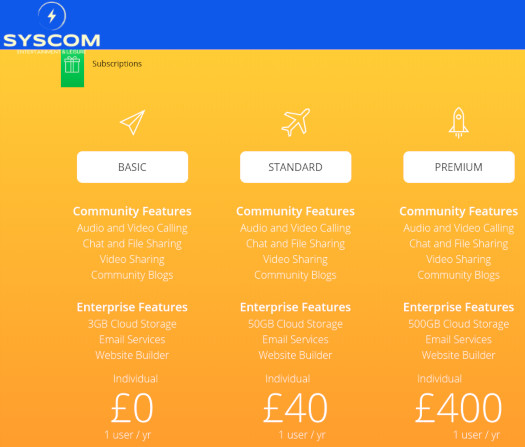
In addition to basic communication features, the subscriptions provide access to web hosting, email services and cloud storage.
In the screenshot above, taken from Syscom’s website, the “basic”, “standard” and “premium” buttons don’t work.
There is no way to sign up for a plan so I’m assuming only DaBank Economy affiliates can purchase them.
This suggests DaBank Economy has no retailable products or services.
Dabank Economy’s Compensation Plan
DaBank Economy does not provide a copy of its compensation plan on its website.
I found various affiliate marketing presentations dating back to 2016. The analysis below is based on several presentations uploaded to YouTube this year.
They all seem to rely on the same source material, which I assume is provided by DaBank Economy directly.
It should be noted that DaBank Economy’s compensation presentation is poorly presented.
Nonetheless I’ve done my best to make sense of as much of it as I can.
Dabank Economy Affiliate Ranks
There are nine affiliate ranks within DaBank Economy’s compensation plan.
Along with their respective qualification criteria, they are as follows:
- Affiliate – sign up as a DaBank Economy affiliate
- Jasper – generate 150 GV on both sides of your binary team over 180 days
- Amber – generate 500 GV on both sides of your binary team over 365 days
- Pearl – generate 3000 GV on both sides of your binary team over 540 days
- Topaz – generate 10,000 GV on both sides of your binary team over 730 days
- Ruby – generate 20,000 GV on both sides of your binary team
- Sapphire – generate 40,000 GV on both sides of your binary team
- Emerald – generate 80,000 GV on both sides of your binary team
- Diamond – generate 240,000 GV on both sides of your binary team
There appears to be additional “Royal” and “Regal” ranks, however their qualification criteria isn’t clearly explained.
These ranks have their own reward bonuses but I’ve omitted them due to their qualification criteria being unclear.
Residual Commissions (unilevel)
A unilevel compensation structure places an affiliate at the top of a unilevel team, with every personally recruited affiliate placed directly under them (level 1):

If any level 1 affiliates recruit new affiliates, they are placed on level 2 of the original affiliate’s unilevel team.
If any level 2 affiliates recruit new affiliates, they are placed on level 3 and so on and so forth down a theoretical infinite number of levels.
From what I can gather “rewards” are calculated based on activity of personally recruited and the unilevel team.
Here’s an example for DaBank Novice tier affiliates:

DaBank Executive tier affiliates receive higher rewards:
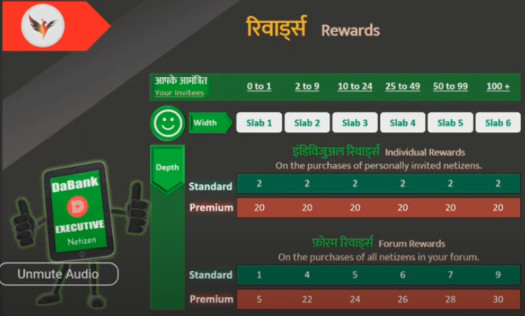
Are these commissions, percentages or what? DaBank Economy’s compensation plan doesn’t state.
Residual Commissions (binary)
A binary compensation structure places an affiliate at the top of a binary team, split into two sides (left and right):
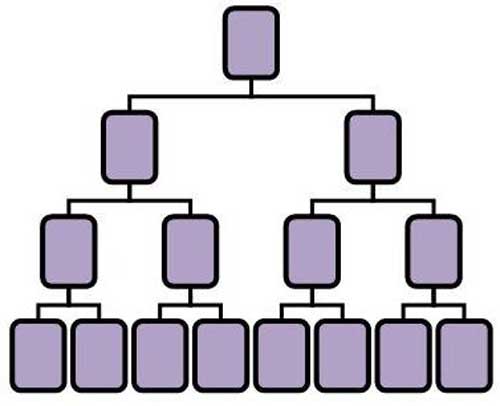
The first level of the binary team houses two positions. The second level of the binary team is generated by splitting these first two positions into another two positions each (4 positions).
Subsequent levels of the binary team are generated as required, with each new level housing twice as many positions as the previous level.
Positions in the binary team are filled via direct and indirect recruitment of affiliates. Note there is no limit to how deep a binary team can grow.
How DaBank Economy pays residual binary commissions out is unclear.
Beyond tracking spend across the binary team, “1 RP = £1 GBP”,
Imperial Club
The Imperial Club appears to be based on a 2×3 matrix.
A 2×3 matrix places an affiliate at the top of a matrix, with two positions directly under them:
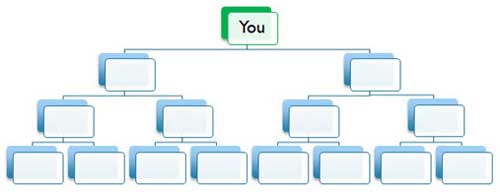
These two positions form the first level of the matrix. The second level of the matrix is generated by splitting these first two positions into another positions each.
The third level of the matrix is generated in the same manner and houses eight positions.
Positions in the matrix are filled via direct and indirect recruitment of DaBank Economy affiliates.
Once all fourteen positions are filled;
- the top position receives 560 points;
- the two first level positions receive 160 points; and
- the eight second level positions receive 80 points
Once a matrix is filled the top position cycles. The two second level positions form the first level of a new matrix.
The second level of these matrices are filled by the third level of the original matrix, leaving eight new positions in each matrix to be filled by new recruits.
Rank Achievement Bonus
DaBank Economy rewards affiliates who qualify at the Amber and higher ranks receive a one-time Rank Achievement Bonus:
- qualify at Amber and receive £800 GBP
- qualify at Gold and receive £6000 GBP
- qualify at Topaz and receive £12,000 GBP
- qualify at Ruby and receive £18,000 GBP
- qualify at Sapphire and receive £36,000 GBP
- qualify at Emerald and receive £80,000 GBP
- qualify at Diamond and receive £450,000 GBP
- qualify at Royal Amber and receive
Joining DaBank Economy
DaBank Economy affiliate membership costs are not disclosed.
Conclusion
Whilst affiliate membership costs and compensation details are a murky mess, I believe I have a general idea of what DaBank Economy is about.
DaBank Economy launched back in 2016. Back then the bundled service was “Fun2sh”, a collection of garbage “me too” mobile apps.

That flopped and at some point EonNet was introduced. EonNet functioned as a social media network. It’s difficult to tell specifically as there’s limited information in English out there.
There is a DaBank Economy app, so maybe EonNet exists within that.
In any event EonNet has taken a backseat to Syscom, the current subscription offering.
Syscom subscriptions can be broken down into two components; communications and web services.
Considering there are an abundance of free communication app
s, why on Earth would you pay for Syscom’s service? Syscom themselves offer a free subscription tier.
With respect to the “enterprise features”, as a website owner myself, I can tell you nobody who is serious about web hosting is putting anything of value on a random service.
And considering Syscom divulge absolutely nothing about the technical specs of the offered web services, that’s exactly what it is; a random service run by person(s) unknown.
Analysis of Syscom subscriptions reveals DaBank Economy’s business model; sign up (pay fees?), buy a Syscom subscription and recruit others who do the same.
At a pure retail level Syscom subscriptions are not viable – the free web hosting tier might be viable doesn’t generate any revenue.
Technical specs for the two paid tiers are not available, let alone the fact you can’t sign up for them outside of DaBank Economy anyway.
On its website, DaBank Economy claims to be
a rising conglomerate in the sector of data collection for Market Research, Product Promotion and Advertisement activities.
Yet after four years, all DaBank Economy seems to have are two dead websites.
DaBank Economy is a convoluted pyramid scheme. As with all MLM pyramid schemes, once recruitment dries up DaBank Economy will collapse.
The math behind pyramid schemes guarantees that the majority of participants will lose money.

